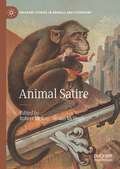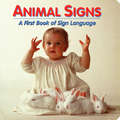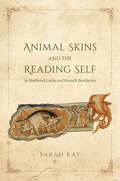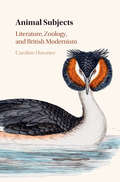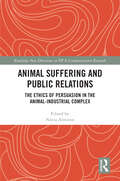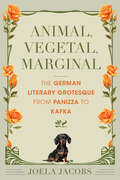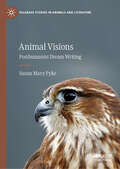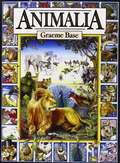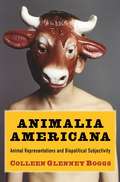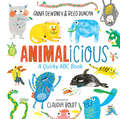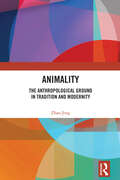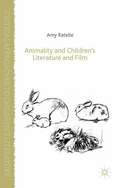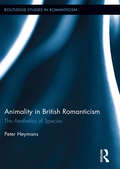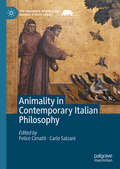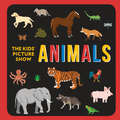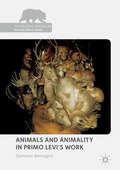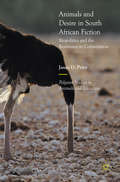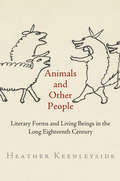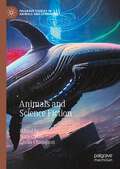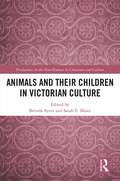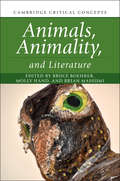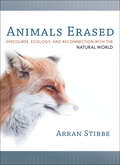- Table View
- List View
Animal Satire (Palgrave Studies in Animals and Literature)
by Robert McKay Susan McHughAnimal Satire presents a cultural history of animal satire, a critically neglected but persistent presence in the history of cultural production, in which animals expose human folly while the strategies of satire expose the folly of human-animal relations. Highlighting the teeming animal presences across the history of satirical expression from Aristophanes to Twitter, with chapters on key works of literature, drama, film, and a plethora of satirical media, Animal Satire reveals the rich rhetorical significance of animality in powering the politics of satire from ancient and medieval through modern and contemporary times. More pressingly, the book makes the case for the significance of satire for understanding the real-world implications of rhetoric about animals in ongoing struggles for justice. By gathering both critical and creative examples from representative media forms, historical periods, and continents, this volume aims to enrich scholarship on the history of satire as well as empower creative practitioners with ideas about its practical applications today.
Animal Signs: Animal Signs
by Debbie SlierCharming, full-color photographs of basic animals plus illustrations of their corresponding signs offer children ages 1 to 4 a fun way to learn their first signs and vocabulary words. Constructed of sturdy cardboard with a protective finish on each page, this hearty book will withstand the hard use to which fascinated young children will subject it, reading it again and again. Studies have shown that babies who learn to sign can communicate at an earlier age than those who learn verbal communication alone. Other research indicates that children strengthen their grammar and vocabulary skills by learning sign language. Animal Signs and its companion book, Word Signs, offer children exciting new worlds describing favorite things and animals while also making learning language skills fun!
Animal Skins and the Reading Self in Medieval Latin and French Bestiaries
by Sarah KayJust like we do today, people in medieval times struggled with the concept of human exceptionalism and the significance of other creatures. Nowhere is this more apparent than in the medieval bestiary. Sarah Kay’s exploration of French and Latin bestiaries offers fresh insight into how this prominent genre challenged the boundary between its human readers and other animals. Bestiaries present accounts of animals whose fantastic behaviors should be imitated or avoided, depending on the given trait. In a highly original argument, Kay suggests that the association of beasts with books is here both literal and material, as nearly all surviving bestiaries are copied on parchment made of animal skin, which also resembles human skin. Using a rich array of examples, she shows how the content and materiality of bestiaries are linked due to the continual references in the texts to the skins of other animals, as well as the ways in which the pages themselves repeatedly—and at times, it would seem, deliberately—intervene in the reading process. A vital contribution to animal studies and medieval manuscript studies, this book sheds new light on the European bestiary and its profound power to shape readers’ own identities.
Animal Subjects: Literature, Zoology, and British Modernism
by Caroline HovanecAnimal Subjects identifies a new understanding of animals in modernist literature and science. Drawing on Darwin's evolutionary theory, British writers and scientists of the late nineteenth and early twentieth centuries began to think of animals as subjects dwelling in their own animal worlds. Both science and literature aimed to capture the complexity of animal life, and their shared attention to animals pulled the two disciplines closer together. It led scientists to borrow the literary techniques of fiction and poetry, and writers to borrow the observational methods of zoology. Animal Subjects tracks the coevolution of literature and zoology in works by H. G. Wells, Aldous Huxley, D. H. Lawrence, Virginia Woolf, and modern scientists including Julian Huxley, Charles Elton, and J. B. S. Haldane. Examining the rise of ecology, ethology, and animal psychology, this book shows how new, subject-centered approaches to the study of animals transformed literature and science in the modernist period.
Animal Suffering and Public Relations: The Ethics of Persuasion in the Animal-Industrial Complex (Routledge New Directions in PR & Communication Research)
by Núria AlmironAnimal Suffering and Public Relations conducts an ethical assessment of public relations, mainly persuasive communication and lobbying, as deployed by some of the main businesses involved in the animal industrial complex – the industries participating in the systematic and institutionalized exploitation of animals. Society has been experiencing a growing ethical concern regarding humans’ (ab)use of other animals. This is a trend first promoted by the development of animal ethics – which claims any sentient being, because of sentience, deserves moral consideration – and more recently by other approaches from the social sciences, including critical animal studies. In this volume, we aim to start an entirely unaddressed discussion within the field of public relations: the need to problematize the ethics of persuasion when nonhuman animal suffering is involved, particularly the impact of persuasion and lobbying on compassion towards other animals in the cases of food, experimentation, entertainment and environment management. The books provides an interdisciplinary, theoretical discussion illustrated with international case studies from experts in strategic communication, public relations, lobbying and advocacy, animal ethics, philosophy of law, political philosophy and social psychology. This unique book merges the fields of critical public relations, animal ethics and critical animal studies and will be of direct appeal to a wide range of researchers, academics and doctoral students across related fields.
Animal Suffering and Public Relations: The Ethics of Persuasion in the Animal-Industrial Complex (Routledge New Directions in PR & Communication Research)
by Núria AlmironAnimal Suffering and Public Relations conducts an ethical assessment of public relations, mainly persuasive communication and lobbying, as deployed by some of the main businesses involved in the animal-industrial complex—the industries participating in the systematic and institutionalised exploitation of animals.Society has been experiencing a growing ethical concern regarding humans’ (ab)use of other animals. This is a trend first promoted by the development of animal ethics—which claims any sentient being, because of sentience, deserves moral consideration—and more recently by other approaches from the social sciences, including critical animal studies. In this volume, we aim to start an entirely unaddressed discussion within the field of public relations: The need to problematise the ethics of persuasion when nonhuman animal suffering is involved, particularly the impact of persuasion and lobbying on compassion towards other animals in the cases of food, experimentation, entertainment, and environmental management. This book provides an interdisciplinary, theoretical discussion illustrated with international case studies from experts in strategic communication, public relations, lobbying and advocacy, animal ethics, philosophy of law, political philosophy, and social psychology.This unique book merges the fields of critical public relations, animal ethics, and critical animal studies and will be of direct appeal to a wide range of researchers, academics, and doctoral students across related fields.
Animal, Vegetal, Marginal: The German Literary Grotesque from Panizza to Kafka (German Jewish Cultures)
by Joela JacobsBetween the Kaiser's and Hitler's Reichs, the genre of die Groteske, or the German literary grotesque, sold out cabarets, drew droves of radio listeners, and created bestsellers with its irreverent comedy and critique. At the same time, its authors were ruthlessly censored for their satire of society, leaving die Groteske virtually unknown today.As the first full-length study of the genre, Animal, Vegetal, Marginal recovers this short prose form, which draws on the perspectives of marginalized animals, plants, and individuals to challenge what it means to be human. Author Joela Jacobs traces the development of the genre and its variations from the work of Oskar Panizza, Hanns Heinz Ewers, and Salomo Friedlaender to Franz Kafka.Animal, Vegetal, Marginal shows how marginalized and nonhuman voices mounted resistance against the rise of the biopolitical structures underpinning nationalism, racism, and antisemitism in the decades leading up to the Second World War.
Animal Visions: Posthumanist Dream Writing (Palgrave Studies in Animals and Literature)
by Susan Mary PykeAnimal Visions considers how literature responds to the harms of anthropocentricism, working with Emily Brontë’s Wuthering Heights (1847) and various adaptations of this canonistic novel to show how posthumanist dream writing unsettles the privileging of the human species over other species. Two feminist and post-Freudian responses, Kathy Acker’s poem “Obsession” (1992) and Anne Carson’s “The Glass Essay” (1997) most strongly extend Brontë’s dream writing in this direction. Building on the trope of a ludic Cathy ghost who refuses the containment of logic and reason, these and other adaptations offer the gift of a radical peri-hysteria. This emotional excess is most clearly seen in Kate Bush’s music video “Wuthering Heights” (1978) and Peter Kosminsky’s film Wuthering Heights (1992). Such disturbances make space for a moor love that is particularly evident in Jane Urquhart’s novel Changing Heaven (1989) and, to a lesser extent Sylvia Plath’s poem, “Wuthering Heights” (1961). Brontë’s Wuthering Heights and its most productive afterings make space for co-affective relations between humans and other animal beings. Andrea Arnold’s film Wuthering Heights (2011) and Luis Buñuel’s Abismos de Pasión (1954) also highlight the rupturing split gaze of non-acting animals in their films. In all of these works depictions of intra-active and entangled responses between animals show the potential for dynamic and generative multispecies relations, where the human is one animal amongst the kin of the world.
Animalia
by Graeme BaseAn alphabet book with fantastic and detailed pictures, bearing such labels as Lazy lions lounging in the local library..
Animalia Americana: Animal Representations and Biopolitical Subjectivity (Critical Perspectives on Animals: Theory, Culture, Science, and Law)
by Colleen BoggsColleen Glenney Boggs puts animal representation at the center of the making of the liberal American subject. Concentrating on the formative and disruptive presence of animals in the writings of Frederick Douglass, Edgar Allan Poe, and Emily Dickinson, Boggs argues that animals are critical to the ways in which Americans enact their humanity and regulate subjects in the biopolitical state. <P><P>Biopower, or a politics that extends its reach to life, thrives on the strategic ambivalence between who is considered human and what is judged as animal. It generates a space of indeterminacy in which animal representations intervene to define and challenge the parameters of subjectivity. The renegotiation of the species line produces a tension that is never fully regulated. Therefore, as both figures of radical alterity and the embodiment of biopolitics, animals are simultaneously exceptional and exemplary to the biopolitical state. An original contribution to animal studies, American studies, critical race theory, and posthumanist inquiry, Boggs thrillingly reinterprets a long and highly contentious human-animal history.
Animalicious: A Quirky ABC Book
by Anna Dewdney Reed DuncanA seriously silly ABC book packed with imaginary animals from the creator of the Llama Llama books, Anna Dewdney, and Reed Duncan.From A is for Anonymouse and I is for Incredibull, to K is for Kangarude and R is for Rocktopus, this ABC book will have readers laughing out loud as they learn the alphabet with animals they may never have seen--or even heard of--before.
Animality: The Anthropological Ground in Tradition and Modernity
by Zhao JingBy addressing the Western understanding of the status and nature of animals and the relation of animals to the question of life, this book provides a discourse on animality through an interdisciplinary investigation into various areas of humanities. The nature of animals is explored by drawing on materials from literature, art, religion, philosophy, and political science, focusing on discussions of animality about the classical culture of ancient Greece, metaphysics and its application to debates on life, Martin Heidegger’s philosophical theories, and biopolitics. Although the distinctive difference between human beings from animals has long been emphasized, the author argues that they are inseparable from one another to achieve understanding. The interrogation of animality, therefore, provides a new perspective on the nature of human beings in this postmodern era. Academics in Western literature, literary theory, literary criticism and comparative literature will find this work an insightful addition to debates in their respective fields, whilst it will also help senior university students pursuing their studies.
Animality and Children’s Literature and Film
by Amy RatelleExamining culturally significant works of children's culture through a posthumanist, or animality studies lens, Animality and Children's Literature and Film argues that Western philosophy's objective to establish a notion of an exclusively human subjectivity is continually countered in the very texts that ostensibly work to this end.
Animality in British Romanticism: The Aesthetics of Species (Routledge Studies in Romanticism)
by Peter HeymansThe scientific, political, and industrial revolutions of the Romantic period transformed the status of humans and redefined the concept of species. This book examines literary representations of human and non-human animality in British Romanticism. The book’s novel approach focuses on the role of aesthetic taste in the Romantic understanding of the animal. Concentrating on the discourses of the sublime, the beautiful, and the ugly, Heymans argues that the Romantics’ aesthetic views of animality influenced—and were influenced by—their moral, scientific, political, and theological judgment. The study reveals how feelings of environmental alienation and disgust played a positive moral role in animal rights poetry, why ugliness presented such a major problem for Romantic-period scientists and theologians, and how, in political writings, the violent yet awe-inspiring power of exotic species came to symbolize the beauty and terror of the French Revolution. Linking the works of Wordsworth, Blake, Coleridge, Byron, the Shelleys, Erasmus Darwin, and William Paley to the theories of Immanuel Kant and Edmund Burke, this book brings an original perspective to the fields of ecocriticism, animal studies, and literature and science studies.
Animality in Contemporary Italian Philosophy (The Palgrave Macmillan Animal Ethics Series)
by Carlo Salzani Felice CimattiThis volume provides an overview of contemporary Italian philosophy from the perspective of animality. Its rationale rests on two main premises: the great topicality of both Italian contemporary philosophy (the so-called “Italian Theory”) and of the animal question (the so-called “animal turn” in the humanities and the social sciences) in the contemporary philosophical panorama. The volume not only intersects these two axes, illuminating Italian Theory through the animal question, but also proposes an original thesis: that the animal question is a central and founding issue of contemporary Italian philosophy. It combines historical-descriptive chapters with analyses of the theme in several philosophical branches, such as biopolitics, Posthumanism, Marxism, Feminism, Antispeciesism and Theology, and with original contributions by renowned authors of contemporary Italian (animal) philosophy. The volume is both historical-descriptive and speculative and is intended for a broad academic audience, embracing both Italian studies and Animal studies at all levels.
Animals (The Kids' Picture Show)
by Chieri DeGregorio Steve DeGregorioGet ready for an animal adventure with your little explorer! The Kids' Picture Show books, inspired by the hugely popular YouTube channel, introduce young readers to first words in cool 8-bit style.This sturdy board book, packed with images of animals, is the perfect introduction to creatures from around the world for babies and toddlers. The 8-bit illustration style makes the book even more fun and accessible for young children, and will also appeal to parents, grandparents, and everyone who has played classic video arcade games.
Animals and Animality in Primo Levi’s Work (The Palgrave Macmillan Animal Ethics Series)
by Damiano BenvegnùSituated at the intersection of animal studies and literary theory, this book explores the remarkable and subtly pervasive web of animal imagery, metaphors, and concepts in the work of the Jewish-Italian writer, chemist, and Holocaust survivor Primo Levi (1919-1987). Relatively unexamined by scholars, the complex and extensive animal imagery Levi employed in his literary works offers new insights into the aesthetical and ethical function of testimony, as well as an original perspective on contemporary debates surrounding human-animal relationships and posthumanism. The three main sections that compose the book mirror Levi’s approach to non-human animals and animality: from an unquestionable bio-ethical origin (“Suffering”); through an investigation of the relationships between writing, technology, and animality (“Techne”); to a creative intellectual project in which literary animals both counterbalance the inevitable suffering of all creatures, and suggest a transformative image of interspecific community (“Creation”).
Animals and Desire in South African Fiction: Biopolitics and the Resistance to Colonization (Palgrave Studies in Animals and Literature)
by Jason D. PriceThis book considers the political potential of affective experiences of desire as reflected in contemporary South African literature. Jason Price argues that definitions of desire deployed by capitalist and colonial culture maintain social inequality by managing relations to ensure a steady flow of capital and pleasure for the dominant classes, whereas affective encounters with animals reveal the nonhuman nature of desire, a biopower that, in its unpredictability, can frustrate regimes of management and control. Price wonders how animals' different desires might enable new modes of thought to positively transform and resist the status quo. This book contends that South African literary works employ nonhuman desire and certain indigenous notions of desire to imagine a South Africa that can be markedly different from the past.
Animals and Other People: Literary Forms and Living Beings in the Long Eighteenth Century
by Heather KeenleysideIn Animals and Other People, Heather Keenleyside argues for the central role of literary modes of knowledge in apprehending animal life. Keenleyside focuses on writers who populate their poetry, novels, and children's stories with conspicuously figurative animals, experiment with conventional genres like the beast fable, and write the "lives" of mice as well as men. From such writers—including James Thomson, Daniel Defoe, Jonathan Swift, Laurence Sterne, Anna Letitia Barbauld, and others—she recovers a key insight about the representation of living beings: when we think and write about animals, we are never in the territory of strictly literal description, relying solely on the evidence of our senses. Indeed, any description of animals involves personification of a sort, if we understand personification not as a rhetorical ornament but as a fundamental part of our descriptive and conceptual repertoire, essential for distinguishing living beings from things.Throughout the book, animals are characterized by a distinctive mode of agency and generality; they are at once moving and being moved, at once individual beings and generic or species figures (every cat is also "The Cat"). Animals thus become figures with which to think about key philosophical questions about the nature of human agency and of social and political community. They also come into view as potential participants in that community, as one sort of "people" among others. Demonstrating the centrality of animals to an eighteenth-century literary and philosophical tradition, Animals and Other People also argues for the importance of this tradition to current discussions of what life is and how we might live together.
Animals and Science Fiction (Palgrave Studies in Animals and Literature)
by Nora Castle Giulia ChampionAnimals and Science Fiction is the first edited collection to be published focusing on the intersection of animal studies and science fiction studies. It offers a broad range of theoretical approaches and primary source texts—including novels, short stories, poetry, film and TV, photography, erotica, video games, and urban planning documents—that explore the ways works of science fiction can transform how we see and interact with nonhuman others. With an eye toward more just multispecies futures, it argues that speculative imaginaries can be pivotal in changing attitudes toward and understandings of nonhuman animals in our world today. Chapters appeal to those interested in biopolitics, posthumanism, new materialism, ecocriticism and the environmental humanities, ocean humanities, postcolonial studies, critical race studies, Indigenous studies, global sf studies, film studies, and food studies. Taken together, the collection works to showcase a diverse and growing field ofscholarly inquiry into animals and science fiction.
Animals and Their Children in Victorian Culture (Perspectives on the Non-Human in Literature and Culture)
by Brenda Ayres Sarah Elizabeth MaierWhether a secularized morality, biblical worldview, or unstated set of mores, the Victorian period can and always will be distinguished from those before and after for its pervasive sense of the "proper way" of thinking, speaking, doing, and acting. Animals in literature taught Victorian children how to be behave. If you are a postmodern posthumanist, you might argue, "But the animals in literature did not write their own accounts." Animal characters may be the creations of writers’ imagination, but animals did and do exist in their own right, as did and do humans. The original essays in Animals and Their Children in Victorian explore the representation of animals in children’s literature by resisting an anthropomorphized perception of them. Instead of focusing on the domestication of animals, this book analyzes how animals in literature "civilize" children, teaching them how to get along with fellow creatures—both human and nonhuman.
Animals, Animality, and Literature (Cambridge Critical Concepts)
by Bruce Boehrer Molly Hand Brian MassumiAnimals, Animality, and Literature offers readers a one-volume survey of the field of literary animal studies in both its theoretical and applied dimensions. Focusing on English literary history, with scrupulous attention to the interplay between English and foreign influences, this collection gathers together the work of nineteen internationally noted specialists in this growing discipline. Offering discussion of English literary works from Beowulf to Virginia Woolf and beyond, this book explores the ways human/animal difference has been historically activated within the literary context: in devotional works, in philosophical and zoological treatises, in plays and poems and novels, and more recently within emerging narrative genres such as cinema and animation. With an introductory overview of the historical development of animal studies and afterword looking to the field's future possibilities, Animals, Animality, and Literature provides a wide-ranging survey of where this discipline currently stands.
Animals Erased: Discourse, Ecology, and Reconnection with the Natural World
by Arran Stibbe“Amazingly clear and incisive readings of a wide range of discourses related to animals and ecology” from the author of Ecolinguistics (Karla Armbruster, coeditor of Beyond Nature Writing).Animals are disappearing, vanishing, and dying out—not just in the physical sense of becoming extinct, but in the sense of being erased from our consciousness. Increasingly, interactions with animals happen at a remove: mediated by nature programs, books, and cartoons; framed by the enclosures of zoos and aquariums; distanced by the museum cases that display lifeless bodies. In this thought-provoking book, Arran Stibbe takes us on a journey of discovery, revealing the many ways in which language affects our relationships with animals and the natural world. Animal-product industry manuals, school textbooks, ecological reports, media coverage of environmental issues, and animal-rights polemics all commonly portray animals as inanimate objects or passive victims. In his search for an alternative to these negative forms of discourse, Stibbe turns to the traditional culture of Japan. Within Zen philosophy, haiku poetry, and even contemporary children’s animated films, animals appear as active agents, leading their own lives for their own purposes, and of value in themselves.“Those of us of cultures of the land—both working with and, yes, consuming animals—will applaud Arran Stibbe’s analysis of the loss of soul when right relationship is discarded.” —Alastair McIntosh, author of Soil and Soul
